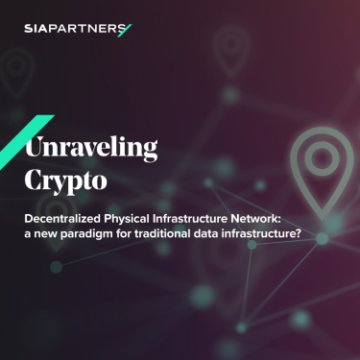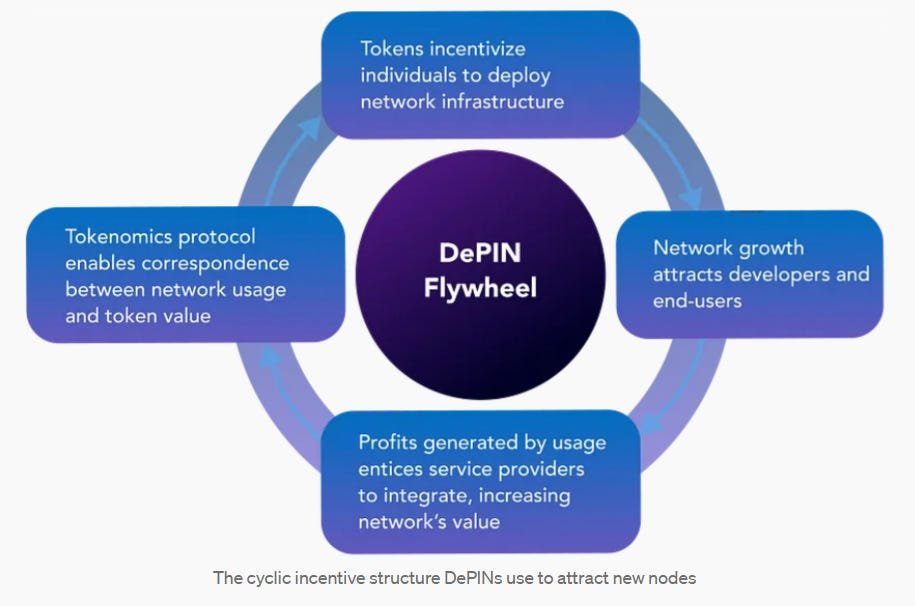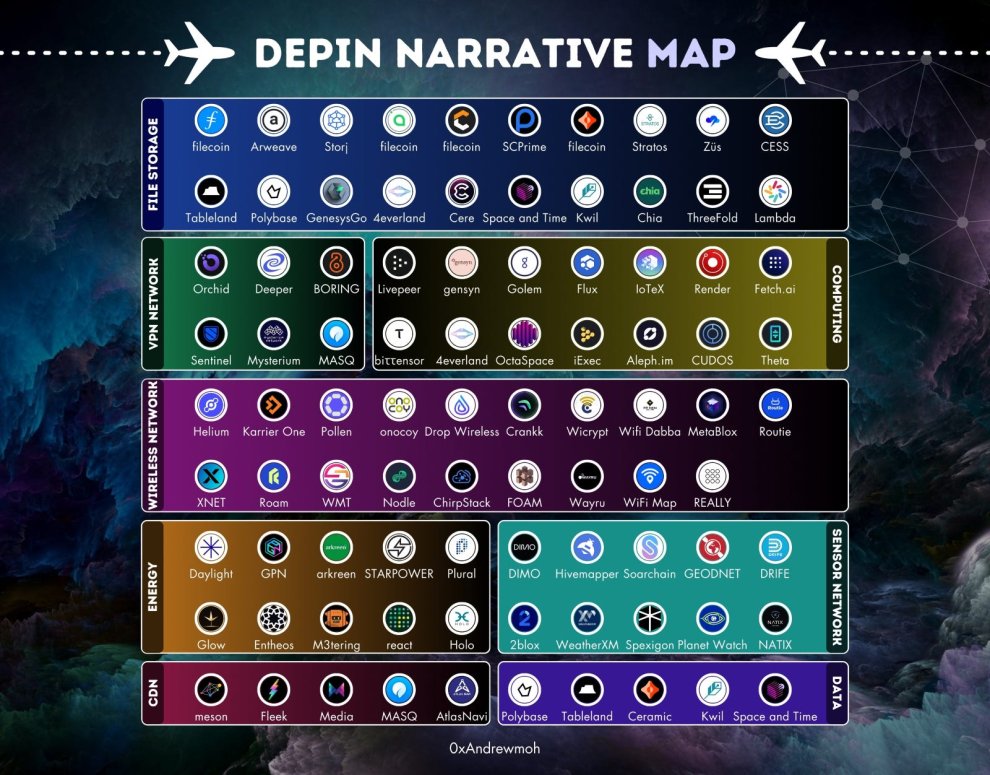Decentralized Physical Infrastructure Network: a new paradigm for traditional data infrastructure?
DePINs, short for Decentralized Physical Infrastructure Networks, refer to physical infrastructure networks managed on a decentralized basis.
Unlike traditional systems based on centralized management by large groups, DePINs involve operation by individuals or small groups.
This decentralized approach relies on the use blockchain technology and of crypto tokens as incentives to motivate participants to share their available resources such as storage capacity, energy, computing power, etc.

GAFAM's hegemony challenged
However, the emergence of DePINs is reshaping this landscape. These networks offer a decentralized approach facilitated by participatory financing models akin to crowdfunding. They present a more accessible and potentially fairer alternative, enabling small businesses and startups to develop and oversee infrastructure without massive initial capital investments.
DePINs have the potential to drive innovation and efficiency in the sector. With heightened competition, end-users stand to benefit from diversified services, reduced costs, and enhanced quality of service. The decentralized nature of DePINs aligns with the core tenets of Web3, advocating for transparency, resilience, and autonomy.
Moreover, DePINs exhibit versatility, finding application across various sectors, including crowd-sourced geographical services and blockchain-powered infrastructural marketplaces.
DePINs are divided into two main categories
Physical Resource Networks : PRNs are decentralized networks of physical resources based on location. Participants contribute hardware resources related to connectivity, mobility, energy, and similar fields to provide services. These resources are tied to specific locations and are non-fungible, meaning they are localized and sometimes non-portable.
Digital Resource Networks : DRNs, on the other hand, consist of networks of fungible digital resource providers. Participants contribute resources such as computing power, shared bandwidth, or storage facilities. Unlike PRNs, these resources are not tied to specific locations or related to locational data.
The DePIN framework primarily consists of four key components
-
Physical Infrastructure encompasses tangible, real-world elements such as servers, sensors, and connectivity hardware, which are fundamental for establishing the network's physical presence and capabilities.
-
Compute Infrastructure refers to the middleware necessary for processing real-world data before integrating it into the blockchain network. It plays a critical role in managing and interpreting the data collected by the physical infrastructure.
-
Blockchain Architecture : serves as the foundational technology for decentralized infrastructures, offering a decentralized and secure ledger to exchange data. It is essential for maintaining device registries and supporting the network's token economy.
-
Token Incentives : Tokens function as both a reward mechanism to incentivize network participants and as the currency within the network's economy. This incentivization mechanism is central to encouraging contributors to develop and sustain the network.
How a DePIN works
Like any network, DePIN operates on two fundamental components : the physical infrastructure and the digital backbone. The physical infrastructure includes elements like wireless hotspot linked to the network via a controller like a mini-computer. Meanwhile, the digital backbone comprises smart contracts managing various project aspects, running on a blockchain network, ideally public and permissionless.The blockchain serves as the network's ledger, documenting transactions and value exchanges among members, such as buying broadband access from router renters.
In the absence of centralized controls, the main challenge is to verify the accuracy of data exchanged in decentralized device networks, and to check their integrity before they are shared on a blockchain.
This is what PEAQ (a blockchain layer-1 project) is tackling by introducing a data verification framework tailored for decentralized physical infrastructure networks (DePINs). This framework, structured into three tiers encompassing cryptographic signing, machine learning for pattern recognition, and trusted oracles, serves as a bulwark for ensuring the integrity and provenance of data exchanged within DePINs. By empowering devices to serve as reliable data providers within a decentralized network, PEAQ sets the stage for heightened trust and reliability in DePIN ecosystems.
Flywheel
The Flywheel effect within the DePIN ecosystem is a significant result of an effectient economic model. As the network's usage expands, so does the demand and value of its tokens. Initially, providers are motivated to allocate their physical resources to the decentralized network, aiming for token rewards on top of the remuneration for their services. Many providers, including those with dormant resources, contribute to the network. DePIN then makes these resources available to users, generating revenue through user fees. Users are drawn to the network by its lower service charges compared to corporation-owned facilities.
As the network expands, the native token appreciates in value, leading to increased rewards for providers and heightened attraction for investors and additional providers. This cycle perpetuates, propelling the DePIN flywheel into motion as the network continues to grow.

The conceptual framework of DePIN is characterized by several shared traits
-
Permissionless entry,
-
Distributed infrastructure costs, and
-
Economies of scale.
The DePIN flywheel, powered by native tokens, involves users contributing resources in exchange for token rewards, thereby expanding network capacity and attracting more users. Projects like Filecoin and Helium have broadened the DePIN flywheel beyond hardware to include data infrastructure and blockchain-based consumer data initiatives. Tokens serve as a unified interface, facilitating a new data-driven economy.
This expanded perspective encompasses not only consumer-facing "sensor network projects" but also potential enterprise applications in supply chain or logistics management, with less emphasis on token financialization. Conceptually, DePIN represents the convergence of a decentralized hardware layer with a community-owned new data economy.
Distinguished by enhanced efficiency and resilience compared to centralized infrastructures, DePIN emerges as the premier solution for scaling global infrastructure. But it goes beyond merely reshaping the economy; it actively encourages everyday people to participate in improving public infrastructure. In an era marked by skepticism towards large institutions and frustration with bureaucratic processes, DePIN stands out as a transformative force. It redistributes wealth and power to ordinary individuals and communities, offering a future where individuals, wield significant influence over the development of the infrastructure we rely on daily.
Sectors where some DePIN projects operate
Here are the sectors where various DePIN projects are actively involved :

Wireless :
DePIN initiatives in the wireless sector focus on creating decentralized connectivity-sharing platforms for IoT and cellular devices. These projects incentivize providers to contribute connectivity resources to the network using cryptocurrencies. For instance, projects like Helium employ a multi-token system to reward providers, with tokens serving specific purposes within the network.
Storage Networks :
Decentralized storage networks offer on-demand storage space, with projects like Filecoin working towards a decentralized data storage marketplace. Providers are rewarded in tokens for their contributions to the network.
Compute Networks :
Decentralized compute networks provide computing infrastructure to users by pooling resources from private providers. Projects like Akash operate open marketplaces for computing resources, rewarding providers with tokens.
Geospatial :
DePINs also engage in locational services, incentivizing providers to offer physical locational services and rewarding them with native cryptocurrencies. Projects like Hivemapper crowdsource mapping efforts from the community, rewarding contributors with tokens based on their contributions.
Mobility :
Projects such as DIMO (Digital Infrastructure for Moving Objects) concentrate on managing data for car owners and manufacturing companies. They offer services like vehicle identity systems via NFTs and reward car owners with tokens for providing data through the DIMO application.
Energy :
DePIN projects in the energy sector aim to promote green energy generation by connecting renewable energy providers. Projects like Arkreen incentivize providers to share data on their energy plants, facilitating the development of environment-friendly energy practices.
Health :
DePIN projects in the health sector reward users for providing health-related information, enabling advancements in healthcare. Applications like Healthblocks incentivize users with tokens for completing health-related tasks or providing data.
Bandwidth Networks :
Decentralized bandwidth networks optimize content delivery by incentivizing providers to share bandwidth. Projects like Theta Network and Grass reward providers with tokens, facilitating shared bandwidth across various devices.
Conclusion
The exploration of DePIN signifies a pivotal moment ushering in a future where infrastructure evolves to be not only smarter but also more equitable, efficient, and resilient. By integrating decentralization into the core of physical infrastructure and harnessing blockchain technology alongside token economics for incentivization and governance, DePIN redefines traditional models.
From bolstering security measures to enhancing operational efficiency to fostering community-driven growth, DePIN emerges as a vanguard in reshaping how we perceive and interact with infrastructure in contemporary society.
DePINs represent a significant leap forward in merging blockchain technology with physical infrastructures, offering tangible solutions to sector-specific challenges. The initiatives highlighted in this discourse signify substantial progress towards realizing the promises of Web3.
Crucially, the accessibility and user-friendliness inherent in DePINs underscore their profound impact. One need not possess extensive knowledge of Web3 to engage with these networks and enjoy their benefits. By democratizing access to blockchain technology and rendering it comprehensible, DePINs pave the way for widespread adoption and societal transformation.
In essence, DePINs embody the convergence of technological innovation, decentralized governance, and community empowerment, heralding a future where infrastructure is not only transformed but also democratized for the common good.
Read the original article here : Decentralized Physical Infrastructure Network: a new paradigm for traditional data infrastructure? (substack.com)



